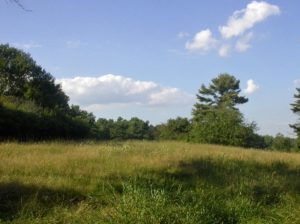
Trail Map | Directions | Milicent Hamilton | Volunteer | Other Sanctuaries
 Hamilton Sanctuary is owned by Maine Audubon as a site for environmental education programs and for the public to use for the enjoyment and appreciation of nature. Encompassing 93 acres, the property is situated in West Bath on a peninsula extending between the New Meadows River and Back Cove.
Hamilton Sanctuary is owned by Maine Audubon as a site for environmental education programs and for the public to use for the enjoyment and appreciation of nature. Encompassing 93 acres, the property is situated in West Bath on a peninsula extending between the New Meadows River and Back Cove.
The sanctuary is traversed by a 2.5 mile trail network that winds through an open meadow and moist coastal forest of spruce and pine. Striking views over a salt marsh and tidal mudflats at Back Cove provide opportunities to see Great Blue Herons, Osprey, and migrant shorebirds and waterfowl.
Hamilton Santuary is open free of charge to the public from dawn to dusk the year round. Enjoy the santuary for nature study, walking, cross-country skiing, snowshoeing or just for its quiet beauty.
Enjoy Your Visit
In order to protect wildlife and ensure an enjoyable visit for all, please stay on the trails, carry out all litter and observe the following posted rules: No pets, fires, camping, firearms, hunting, trapping, collecting, off road vehicles, mountain bikes or alcoholic beverages. Please observe the posted boundaries. A public outhouse is located next to the parking lot.
Directions to Hamilton Sanctuary
Take the New Meadows exit off US Route 1 in West Bath. Turn left onto New Meadows Road and go straight ahead at the stop sign. Here New Meadows Road turns into Foster Point Road. Follow it three miles to the sanctuary sign and parking area on the right.
HamiltonSactuary_TrailMap PDF – Downloadable Trail Map
Millicent Hamilton
Hamilton Sanctuary was given to Maine Audubon by Millicent Hamilton, an avid birder and naturalist who made her home here from the 1940’s until her death in 1986. In 1984 Millicent wrote of the eight-acre meadow:
 “It is a peaceful and beautiful bit of land that has been an important part of my life for many years, to roam afoot or to view from the water. It’s home to the woodcock and bobolinks in the spring, to redwings, catbirds and song sparrows to warblers and flycatchers along the marsh edge. It is spring and autumn grazing ground for the deer. My most fervent desire is that it continue unspoiled for the wildlife, and that many people in the years to come will find peace and joy there as I have done.”
“It is a peaceful and beautiful bit of land that has been an important part of my life for many years, to roam afoot or to view from the water. It’s home to the woodcock and bobolinks in the spring, to redwings, catbirds and song sparrows to warblers and flycatchers along the marsh edge. It is spring and autumn grazing ground for the deer. My most fervent desire is that it continue unspoiled for the wildlife, and that many people in the years to come will find peace and joy there as I have done.”